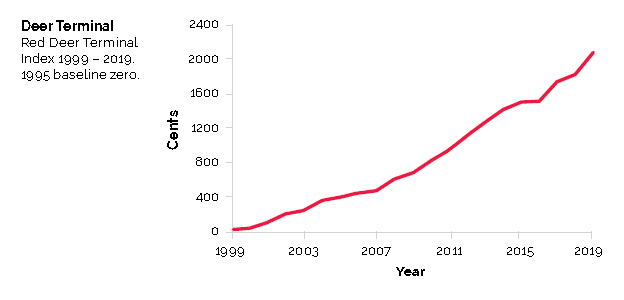Ken Moore has finally hung up his SIL/Deer Select service provider boots, and retired at the age of 77. He reflects on how far the industry has come to achieve the genetic progress which keeps farm businesses viable.
I was employed as a farming tutor in the Christchurch Polytechnic’s (now Ara) science and computing department in the 1980s as the computer age unfolded. At that time MAF offered sheep breeders Sheeplan breeding values (BVs) for growth, fertility, and wool using a mainframe computer. Enter the personal computer when different software groups developed programs for livestock recording. Once MAF dropped its Sheeplan service, the Animal Breeding Trust, Flock-Linc, and the bureaux running Studfax picked up the job. In 1999 Sheep Improvement Limited(SIL) launched, and the data from these three groups combined under the new Jade-based data analysis. I registered as a SIL service provider (NZ Performance Recording Services ) with five flocks in 1999, growing to 123 over time. Exciting days.
Breeders were encouraged to join up with SIL, but fears that computers might generate freak sheep were widespread. It has taken years to break down this misconception, and while SIL is now a farming acronym, change is afoot. The system that has served us well for 21 years is being superseded by nProve. Same process (analysing sheep data to provide breeding values and indexes), but on a new and more powerful platform, with added features like the RamFinder app. Greater levels of breeder access are also in the pipeline.
Another game changer in the past two decades has been the use of DNA for more accurate assigning of parents. Just as important, if not more so, is the discovery of gene markers for key traits like MyoMAX and LoinMAX. This genetically derived information can now be incorporated into the calculations for related breeding values. The ‘Single Step’ evaluation across all SIL recorded flocks takes place every weekend, after which selection lists and sire and dam summaries can be forwarded by service providers to breeders via the internet. Commercial breeders can compare rams from different studs using the SIL breeding values, and maternal and terminal worth indexes via the RamFinder app.
The need to incorporate genes like MyoMAX from one breed to another (e.g. terminal to dual purpose) has led to many breeders breaking away from the registered breed association regulations in order to produce faster growing, meatier, multiple-born lambs. The Beltex, our latest sheep breed import, has extra muscling in the rump, but a gene maker for this trait has not yet been discovered.
Tests for facial eczema (GGT) and worm resistance (FEC, CARLA) provide further data for incorporation into health trait breeding values, leading to significant progress in critical health areas.
Over the past 40 years we’ve moved from handwritten stud records to fully electronic pathways. A breeder can record lambing on a handheld device or mobile phone, uploading weights (utilising electronic ear tags) from electronic scales via bluetooth to a computer. Then off to the SIL/nProve service provider via the internet. Apps are under development so data can go to nProve directly from a mobile phone.


Back in 1980 wool and meat were pretty much equal contributors to farm income. Nowadays with meat the main earner, the steady incremental genetic progress made possible through SIL, and genes like MyoMAX, is helping sheep farmers stay in the black.
The deer industry, a little slower off the blocks when it came to trapping the kind of data needed to drive genetic progress, got cracking with Deer Select. Deer Select runs on the SIL platform, with its own genetic engine. As I was familiar with deer (we had some major deer breeders using Studfax), I was invited to become one of two service providers for Deer Select. Today a good number of red deer and elk/wapiti breeders use Deer Select to make better informed selection decisions. There have been very impressive gains in growth rates and a lift in meat and health trait BVs, as well as terminal and replacement indexes derived from these BVs.
It has been a privilege to be part of the SIL (and Deer Select) story. My main regret is losing regular contact with the breeders I’ve worked with for more than 25 years. Some of these folk are industry leaders and I’m proud to have played my part in their success and, indirectly, to the passing on of improved genetics to commercial farmers.
I’ve been one of only eight independent SIL service providers. They are all very talented and dedicated people standing at the interface between breeders (and their animal data) and the sophisticated software running on banks of computer servers at AgResearch in Hamilton, supported by an equally dedicated band of animal scientists and computer experts driving the whole process. The transition from the MAF of the 1980s to B+LNZ Genetics today is huge. In a world gone crazy over methane emissions as a greenhouse gas we need all the help we can get, and finding ways to reduce methane emitted by ruminants is the next breeding challenge.
After 21 years of steady genetic progress one might think there is no more room for improvement. Amazingly the upward slope of the genetic trend graphs show little sign of tapering off. This is good news for the industry and an incentive for stud breeders to record the data necessary to maintain this ongoing lift in genetic progress.
Moore has sold his business to Barbara and Belinda Beckett.
- Ken Moore worked in farm education in Australia and Tanzania, before taking up a farm tutoring role with Christchurch Polytechnic in 1980. Transitioning to teaching ‘Introduction to Farm Computing’, he established his own business selling and supporting computer software, including the Studfax livestock recording program. Studfax formed the computing platform for his NZ Performance Recording Service, a SIL service provider bureau established in 1999.




